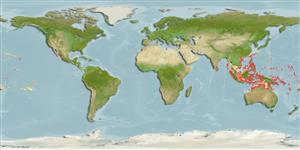>
Gobiiformes (Gobies) >
Gobiidae (Gobies) > Gobiinae
Etymology: Trimma: Greek, trimma, -atos = something crushed (Ref. 45335).
Environment: milieu / climate zone / depth range / distribution range
Ökologie
seewasser riff-verbunden; tiefenbereich 8 - 35 m (Ref. 90102). Tropical; 30°N - 18°S
Western Pacific: Ryukyu and Ogasawara Islands to Rotuma, south to Rowley Shoals in the eastern Indian Ocean and the Great Barrier Reef. Recently recorded from Tonga (Ref. 53797).
Size / Gewicht / Alter
Maturity: Lm ? range ? - ? cm
Max length : 3.5 cm SL Männchen/unbestimmt; (Ref. 48637)
Rückenflossenstacheln (insgesamt) : 7; Rückenflossenweichstrahlen (insgesamt) : 9 - 10; Afterflossenstacheln: 1; Afterflossenweichstrahlen: 8 - 9. Has same general appearance as T. caesiura and T. naudei. Characterized by having greyish matrix with dense orange spotting on head and body; presence of faint spotting on fins; elongate second dorsal spine; fifth pelvic ray branched, 60-70% length of fourth ray; longitudinal scale series 26-27; predorsal scales absent; cheek and opercle without scales; depth of body 4.0-4.4 in SL (Ref. 90102).
Inhabits clear coastal reefs, near sponges (Ref. 48637). Usually hovers upside-down in small caves in coral reefs. Forms small loose groups (Ref. 90102).
Life cycle and mating behavior
Geschlechtsreife | Fortpflanzung | Ablaichen | Eier | Fecundity | Larven
Benthic spawner. Also considered a bi-directional sex changer (Ref. 32022, 103751).
Myers, R.F., 1991. Micronesian reef fishes. Second Ed. Coral Graphics, Barrigada, Guam. 298 p. (Ref. 1602)
IUCN Rote Liste Status (Ref. 130435: Version 2024-2)
Bedrohung für Menschen
Harmless
Nutzung durch Menschen
Fischereien: nicht kommerziell
Tools
Zusatzinformationen
Download XML
Internet Quellen
Estimates based on models
Preferred temperature (Ref.
123201): 26.5 - 29, mean 28 °C (based on 294 cells).
Phylogenetic diversity index (Ref.
82804): PD
50 = 0.5000 [Uniqueness, from 0.5 = low to 2.0 = high].
Bayesian length-weight: a=0.01023 (0.00477 - 0.02194), b=3.01 (2.83 - 3.19), in cm total length, based on LWR estimates for this (Sub)family-body shape (Ref.
93245).
Widerstandsfähigkeit (Ref.
120179): hoch, Verdopplung der Population dauert weniger als 15 Monate. (Preliminary K or Fecundity.).
Fishing Vulnerability (Ref.
59153): Low vulnerability (10 of 100).
Nutrients (Ref.
124155): Calcium = 264 [125, 651] mg/100g; Iron = 1.29 [0.62, 2.52] mg/100g; Protein = 18.2 [16.2, 19.9] %; Omega3 = 0.173 [0.069, 0.376] g/100g; Selenium = 25.6 [10.8, 57.8] μg/100g; VitaminA = 143 [37, 527] μg/100g; Zinc = 3.18 [1.94, 4.93] mg/100g (wet weight);
